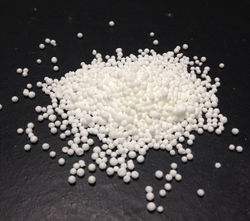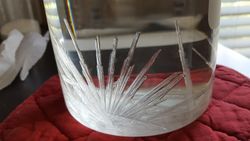Ammonium nitrate
 Prills of store-bought ammonium nitrate which could be found in fertilizer or cold packs.
| |
| Names | |
|---|---|
| IUPAC name
Ammonium nitrate
| |
| Other names
Ammonium nitricum
Ammonium saltpeter Azanium nitrate Nitrate of ammonia | |
| Properties | |
| NH4NO3 | |
| Molar mass | 80.043 g/mol |
| Appearance | White solid |
| Odor | Odorless |
| Density | 1.725 g/cm3 (20 °C) |
| Melting point | 169.6 °C (337.3 °F; 442.8 K) |
| Boiling point | 210 °C (410 °F; 483 K) (decomposes) |
| 118 g/100 ml (0 °C) 150 g/100 ml (20 °C) 297 g/100 ml (40 °C) 410 g/100 ml (60 °C) 576 g/100 ml (80 °C) 1024 g/100 ml (100 °C) | |
| Solubility | Soluble in acetone, anh. ammonia Insoluble in diethyl ether, toluene |
| Solubility in ammonia | 391 g/100 ml (25 °C) |
| Solubility in ethanol | 3.8 g/100 ml (20 °C) |
| Solubility in methanol | 17.1 g/100 ml (20 °C) |
| Solubility in pyridine | 23.35 g/100 ml (25 °C) |
| Hazards | |
| Safety data sheet | Sigma-Aldrich |
| Lethal dose or concentration (LD, LC): | |
| LD50 (Median dose)
|
2,085–5,300 mg/kg (rats, oral) |
| Related compounds | |
| Related compounds
|
Ammonium nitrite Ammonium perchlorate |
| Except where otherwise noted, data are given for materials in their standard state (at 25 °C [77 °F], 100 kPa). | |
| Infobox references | |
Ammonium nitrate is an inorganic compound with the chemical formula NH4NO3. This white crystalline salt finds use as an oxidizer and as a reagent in the production of nitric acid and ammonia.
Contents
Properties
Chemical
Ammonium nitrate, like some other ammonium compounds, is unstable both at high temperatures and at high pH. At high temperatures it decomposes into nitrous oxide and water.
- NH4NO3 → N2O + 2 H2O
In a very useful double replacement reaction, ammonium nitrate can be reacted with sodium hydroxide or sodium carbonate in somewhat differing procedures to yield sodium nitrate, another useful oxidizer, and ammonia gas (with in the latter case carbon dioxide), which can be channeled into cold water to produce a solution.
- NH4NO3 + NaOH → NaNO3 + NH3 + H2O
When sodium hydroxide is used, the chemicals should be added in dry form to a round-bottom or Erlenmeyer flask with a stopper and gas tubing ready to channel the ammonia. Upon the addition of a small amount of water or ice a vigorous reaction begins. If sodium carbonate, which is cheaper and safer, is used instead, the two reactants must be combined in solution and the solution heated until the reaction is complete, when ammonia can no longer be smelled.
Nitric acid is produced when ammonium nitrate is reacted with either sulfuric or hydrochloric acids, along with an ammonium salt.
- H2SO4 + NH4NO3 → HNO3 + NH4HSO4
In general, however, alkali nitrates are preferred, as the separation is better, thus the ammonium nitrate is usually converted into sodium or potassium nitrate first.
A mixture of molten ammonium nitrate, urea and silica gel (added to desensitize the AN), will yield guanidinium nitrate.[1]
Ammonium nitrate can decompose very violently if mixed with a fuel such as diesel or kerosene and hit by a shock wave. This mixture is a high explosive called ANFO (ammonium nitrate-fuel oil). In addition to being very dangerous, detonation of ANFO is very likely to be heard very far away and will almost certainly lead to trouble with the law, so it is not advised.
Physical
Ammonium nitrate appears typically as a hard off-white white crystalline solid or as prills, such as those found in instant cold packs. The dissolution of ammonium nitrate in water is very endothermic, making it useful for cooling baths. Such a cooling bath is convenient in that, because of the salt's high solubility, it can be re-cooled many times during a synthesis by adding more ammonium nitrate. While it is already very soluble in cold water, ammonium nitrate is extremely soluble in boiling water, at 1024 g/100 ml. These factors make re-crystallization difficult, as instead of crystals you are more likely to end up with a large brick of wet ammonium nitrate. Boiling a solution completely to dryness is very dangerous, as rapid decomposition will begin if the solid heats too much, producing nitrous oxide, a potent oxidizer. While only mildly hygroscopic, it is very difficult to dry ammonium nitrate after crystallization, and it is nearly impossible to do without the use of an oven or desiccator (however, leaving it overnight on a 50 C heating radiator does the trick and produces a material dry enough to be ground in a mortar and stored).
Explosive
Pure ammonium nitrate is not explosive under standard conditions, and neither strong heating nor impact will cause it to explode under normal circumstances, but if an explosive charge is used, it will detonate. However, when mixed with oxidizable compounds, like aluminium powder or nitromethane, its sensitivity greatly increases, and a strong impact is enough to cause it to detonate, such as the impact from a gun. The detonation velocity of pure ammonium nitrate is 2500 m/s.
Availability
Due to the use of ammonium nitrate in explosives, the availability of this chemical varies greatly with the country it is being purchased in. It is easily obtainable in often nearly pure form in cheap instant cold packs at pharmacies in the United States. Larger amounts can sometimes be found as a fertilizer, either by itself or with calcium nitrate. In some countries, ammonium nitrate prill fertilizers are mixed with calcium sulfate which makes the material unsuitable for making explosives. In many other countries, however, it is not only not sold, but even restricted or altogether illegal due to fear of its use in bombings. In the EU, ammonium fertilizers tend to be restricted above a certain concentration.
Preparation
Ammonium nitrate can be produced by the combination of nitric acid and ammonia solution, though these two reagents are more often prepared from ammonium nitrate than being used to make it.
- HNO3 + NH3 → NH4NO3
It can also be prepared by mixing two supersaturated solutions of calcium nitrate and ammonium sulfate. The resulting slush is filtrated and the liquid is cooled until ammonium nitrate begins to crystallize.
Projects
- Make nitric acid
- Make ammonia and aq. ammonia
- Make nitrous oxide (laughing gas)
- Make Tannerite
- Make guanidinium nitrate
- Cooling bath
Safety
Handling
Ammonium nitrate is a sensitive oxidizer, though not as sensitive as chlorates or perchlorates, and mixtures of it with organic compounds pose a great danger in substantial amounts. If mixed with bases, toxic and irritating ammonia gas is given off, and in high heat ammonium nitrate decomposes to form nitrous oxide, which can be a dangerous airborne oxidizer in enclosed spaces. Ammonium nitrate must never come in contact with with nitromethane, as this will form the very sensitive ANNM, which may set off the ammonium nitrate if detonated.
While not a matter of physical safety, the purchase, possession, purification or synthesis of ammonium nitrate is often frowned upon by law enforcement, and may require a license in some jurisdictions.
Storage
Ammonium nitrate should be stored in closed containers or bags as it is mild hygroscopic and away from any reducing agents or bases.
Disposal
Ammonium nitrate can be safely released in the environment, in small quantities, except water bodies.
